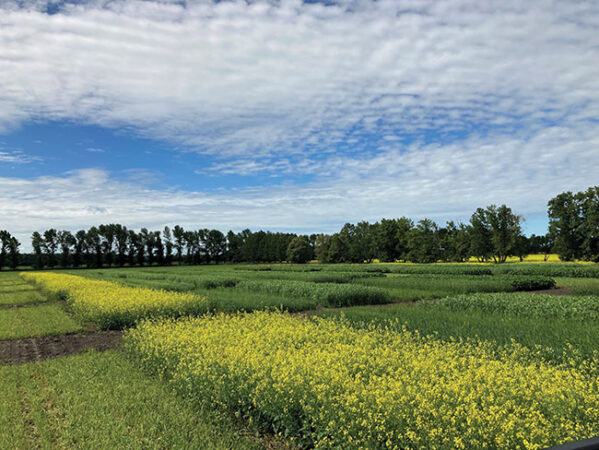
Features
Soil
The nitty-gritty of disease-suppressive soils
Using DNA technologies to uncover which Prairie crop rotations promote pathogen-fighting soil microbes.
February 13, 2023 By Carolyn King
 Wang is aiming to identify crop rotations that tend to have more biocontrol microbes and fewer pathogenic
microbes in their soils.
Photo courtesy of Agriculture and Agri-Food Canada.
Wang is aiming to identify crop rotations that tend to have more biocontrol microbes and fewer pathogenic
microbes in their soils.
Photo courtesy of Agriculture and Agri-Food Canada. An intriguing project is underway in Manitoba and Saskatchewan to examine soil microbial communities right down to the gene level. The aim is to identify crop rotations that will help Prairie crop growers make the most of the biocontrol agents naturally available in their soils to fight major pathogens.
The project’s principal investigator is Xiben Wang, a research scientist with Agriculture and Agri-Food Canada (AAFC) at Morden, Man. His research mainly focuses on Fusarium head blight (FHB) on barley and oats, so he is very interested in sources of Fusarium inoculum.
Fusarium fungus is typically thought of for overwintering on infected crop residues and, then in the next growing season, releasing airborne spores to spread FHB. But Wang notes, “Fusarium not only causes head blight; it is also a very important pathogen causing root rots in pulses, cereals and canola to some extent.” So, the fungus is in the soil, as well.
Thinking about soil-borne Fusarium made Wang curious about the impacts of different agricultural management practices on the amount of Fusarium in Manitoba soils – and, more broadly, on the amounts of many important soil-borne pathogens in Prairie soils.
As a first step in investigating this issue, Wang’s current project is assessing the effects of different crop rotations on the ability of the soil microbiome to suppress crop disease.
He adds, “I am always interested in looking at the use of biological agents to control soil-borne pathogens, especially Fusarium. I think this research may be a good opportunity to look into it.”
Other scientists involved in this project include plant pathologist Randy Kutcher from the University of Saskatchewan, who is a key collaborator, as well as Oscar Molina, a cropping systems agronomist at AAFC-Morden, and Nazrul Islam, a post-doctoral researcher at AAFC-Morden.
The project’s objectives include: determining how different patterns of soil microbial community composition, how abundance and diversity relate to the type of crop rotation, the level of disease in the crops, and the level of pathogens in the soil; and identifying crop rotations that tend to have more biocontrol microbes and fewer pathogenic microbes in their soils.
Using small-plot trials at Morden and Saskatoon, the researchers are comparing two-year rotations involving various combinations of three crop categories: cereal crops, represented by durum wheat, barley and corn; pulses, represented by soybeans and peas; and oilseeds, represented by canola.
Their first set of two-year rotations was in 2020 and 2021, and the second set was in 2021 and 2022. They collected data on such factors as crop disease levels and grain yields. They also collected soil samples on two occasions – in the middle of the growing season and after harvest – for further analysis.
Although the researchers are currently in the process of analyzing their data, Wang shared some preliminary results:
Top five soil-borne fungal pathogens
The project team is using various types of analysis to examine the microbiomes in the soil samples. One component of this DNA work involves metagenomics analysis – looking at the DNA sequences of all the different microbes in each soil sample – to determine the soil microbial community’s composition, abundance and diversity.
Based on the results so far for both field sites, the most common soil-borne fungal pathogens are: Fusarium species (about six per cent of the total DNA sequences); Ustilago species, which cause smuts (about five per cent of the total DNA sequences); Alternaria species, which cause leaf diseases, storage moulds and other problems (about three per cent); Leptosphaeria, which causes blackleg in canola (about three per cent); and Rhizoctonia, which causes root rots (about one per cent).
The high abundance of Ustilago DNA might seem surprising given that smuts are not seen very often on the Prairies. However, Wang explains the only reason why smuts are not much more common in western Canadian crops is that these diseases are well controlled through the use of disease-resistant crop varieties and appropriate seed treatments.
Short rotations, big effect
Another aspect of the team’s analysis is to assess how quickly a crop rotation affects the characteristics of a soil’s microbial community. Some previous studies have examined rotation effects on soil microbiomes in the context of long-term crop rotations. This project is providing valuable insights into the effects of very short rotations.
“From the data we have so far, it seems that one year or two years of a rotation will cause a dramatic impact on the microbial composition in the soil,” says Wang.
“Our analysis clearly differentiates soil microbial populations from, for example, cereal/cereal rotations versus cereal/pulse rotations versus pulse/canola rotations.”

The two-year rotations included in this project are various combinations of cereals, pulses and oilseeds. Photo courtesy of Agriculture and Agri-Food Canada.
Bacterial genes for fighting fungi
Certain bacteria are able to produce compounds that can suppress or kill fungi. The project team is searching through the DNA in the soil samples for specific bacterial genes known to be associated with the production of such anti-fungal compounds.
For this work, they use a protocol called shotgun sequencing, which generates approximately one million DNA sequences from the soil samples. “We screen the DNA sequences we have generated against a panel of about 2,500 different kinds of bacterial genes that could contribute to disease control,” says Wang. “For example, the panel includes genes encoding chitinases, genes encoding different antibiotics and genes encoding siderophores.
“We have just finished our first run of screening. We have found about 50 to 60 of those genes in the soil samples we have collected at Morden and Saskatoon. Now we are looking for correlations between the crop rotation treatment and the abundance of these genes.”
Wang is looking forward to continuing this gene sequencing work with the samples from the second set of their two-year crop rotations because they were able to include more rotation treatments in that second set.
The results of this analysis could give the team a better understanding of which particular biocontrol genes are most important. And, with that information, they might be able to narrow down those 50 to 60 genes to a panel of about 15 to 20 key indicator genes – those genes that are really important for fighting major fungal pathogens, but don’t impact beneficial soil fungi.
Coming next
The team will be finishing their analysis of the data from this crop rotational project over the coming months.
Next, Wang is hoping to use that small panel of key biocontrol genes to screen many more soil samples. Ideally, he would like to collect samples from producers’ fields across Manitoba in order to determine which have the best potential for suppressing important soil-borne pathogens.
Also, along with looking at crop rotation effects, Wang would like to start examining the effects of other practices like tillage, fungicides, fertilizers and resistant/susceptible crop varieties on soil microbiomes.
The findings from this expanded research could give researchers – and crop growers – a better understanding of which crop production systems are best for enhancing biocontrol bacteria populations and suppressing pathogen populations.
“I think it is really important to try to work with nature, to try to promote the native beneficial bacteria in our soils,” notes Wang.
“If we can find ways to promote disease-suppressive soil microbiomes that prevent the spread of crop diseases, that will help Prairie producers to have better crops and lower production costs, and it will help the environment, as well.”
This project is funded by the Western Grains Research Foundation, Manitoba Crop Alliance and Ag Action Manitoba.